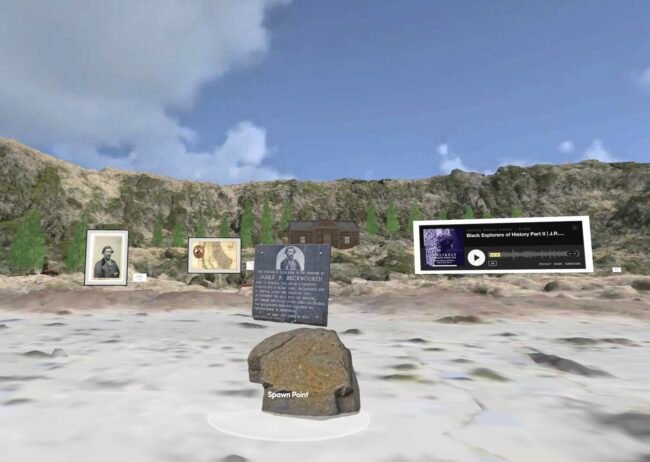
23 Apr Revolutionizing Heritage Education with VR: A Case Study on Jim Beckwourth
In today’s digital age, virtual reality (VR) is more than just an immersive experience for gamers; it’s becoming a pivotal tool in educational fields, especially in historical and cultural studies. At the recent 2024 Association of California Archivist AGM, I had the privilege to present a virtual exhibit, “Journey Through the Life of Jim Beckwourth.” This case study not only showcased the capabilities of browser-based VR in enhancing heritage preservation but also demonstrated its profound impact on educational methodologies.
The Power of VR in Heritage Education: Jim Beckwourth, one of the lesser-known yet fascinating figures of the 19th-century American frontier, was the focal point of my virtual exhibit. By integrating VR technology, I brought to life the nuanced tapestry of Beckwourth’s adventures and contributions. The exhibit was developed using cutting-edge tools like Spatial.io, Sketch Fab for 3D objects, and Envato Elements for enriched graphics, allowing users to traverse through various scenes of Beckwourth’s life, making the past both accessible and engaging.
Engagement and Educational Impact: The feedback from the AGM was positive, with particularly notable engagement about its use by history instructors and its potential in as a teaching tool. The ability to interact with historical artifacts and environments in a virtual space sparked curiosity and facilitated a deeper understanding of complex historical narratives. Information professionals appreciated the exhibit’s capacity to inspire reflection and education, highlighting VR’s role in promoting inclusive and diversified narratives in historical education.
Technical Insights and Development: Creating the “Journey Through the Life of Jim Beckwourth” was both a technical and creative challenge. The project spanned only a few days. During the presentation we discussed the user-friendly design of the VR platforms and the relatively gentle learning curve, assuring information professionals that adopting such technology is both feasible and beneficial. The seamless integration of high-quality 3D models and detailed graphics underscored the potential of VR to transform traditional exhibition methodologies.
Conclusion and Future Directions: The case of Jim Beckwourth’s virtual exhibit marks just the beginning of what I envision for the future of educational exhibits. The discussions at the AGM has opened several avenues for potential collaborations, promising more innovative projects that harness the power of VR in education. For those interested in exploring how VR can enhance their educational content or exhibitions, I am eager to share insights and collaborate on future ventures.
If you’re intrigued by the possibilities of VR in heritage preservation and education, or if you have a project in mind that could benefit from such technology, I invite you to reach out. Let’s work together to make history not just informative but also immersive and interactive. Contact me to discuss how we can bring your historical content to life through virtual reality.
As we continue to explore and expand the boundaries of how we teach and learn about history, VR stands out as a beacon of innovative potential. It’s not just about seeing history; it’s about experiencing it. Join me on this journey to transform historical education into an immersive adventure.
View the details of the case study and its documentation here in my digital portfolio



